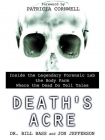Death's Acre: Inside The Legendary Forensic Lab The Body Farm Bill Bass (howl and other poems TXT) 📖

- Author: Bill Bass
Book online «Death's Acre: Inside The Legendary Forensic Lab The Body Farm Bill Bass (howl and other poems TXT) 📖». Author Bill Bass
And at that pivotal moment, the University of Tennessee came calling. So did forensic anthropology. My career as “Indian grave-robber number one” was over. My true vocation—as a forensic scientist—was about to begin.
CHAPTER 3
Bare Bones: Forensics 101
IN A RELATIONSHIP lasting forty years, you can learn a lot about someone. But everybody takes some secrets to the grave.
I first met my longtime teaching partner at the beginning of the fall semester back in 1962. I was a freshly minted Ph.D., teaching at the University of Kansas in Lawrence in between my summer excavations in South Dakota; my partner-to-be was a not-so-fresh corpse lately pulled from a roadside near the Missouri River outside Leavenworth. The body, found by three dove hunters and one bird dog, was down in the floodplain—what the locals call “the bottoms”—where the soil, deposited by occasional floods, was soft and sandy. When the murder occurred it was summertime, and the diggin’ was easy.
As a forensic anthropologist, I tend to see bodies that are long past their prime—bodies that are bloated, blasted, burned, buggy, rotted, sawed, gnawed, liquefied, mummified, or dismembered. Some are even skeletonized, reduced to bare bones—bare, but brimming with data.
Flesh decays; bone endures. Flesh forgets and forgives ancient injuries; bone heals, but it always remembers: a childhood fall, a barroom brawl; the smash of a pistol butt to the temple, the quick sting of a blade between the ribs. The bones capture such moments, preserve a record of them, and reveal them to anyone with eyes trained to see the rich visual record, to hear the faint whispers rising from the dead.
I was in the morgue at University of Tennessee Medical Center recently, and laid out on a metal tray there I saw a heartbreaking sight: the skeleton of an infant, just three months old, battered beyond anything I’ve ever seen. An arm and a leg were broken; so was nearly every tiny rib. The most horrifying part was this: In addition to the fresh, perimortem breaks—those occurring around the time of death—there were numerous other fractures in various stages of healing. This poor child was abused almost from the moment he was born, yet his broken little body kept trying to mend itself. Given half a chance, he would have recovered, because the body’s resilience can be incredible. So, too, is the depth of cruelty in some people. It did my heart good, in a sad sort of way, to read that his mother was later charged with murder and is now awaiting trial.
The adult victim I examined that day back in 1962—the one that would become my teaching partner—was not reduced to bare bones. The examination would have been much more pleasant if that had been the case. The remains arrived in a reeking cardboard box tied with twine to the trunk lid of a black sedan. The two Kansas Bureau of Investigation (KBI) agents who had tied it there didn’t want to stink up their trunk. They didn’t want to stink up their hands, either: “I’m not touching it,” said one of them. “You’ll have to go get it yourself.” So I went out to the parking lot, cut the twine, and carried the box over to the side yard of the university’s Museum of Natural History, which housed my office. Setting the box on the grass, I lifted out a plastic bag, untied its neck, and extracted the remains, piece by rotting piece.
A handful of my braver anthropology students gathered around. The fall term had started only hours before—it was the day after Labor Day—and already things were getting lively. Despite the gruesomeness of it all, studying a freshly unearthed murder victim was a unique learning opportunity, one that few anthropology students—and not all that many professors—ever receive.
When you examine a body in a forensic case, I told the students, the ultimate goal is to make a positive identification. If possible, you also want to determine the cause of death (technically, only medical examiners can determine cause of death; we anthropologists call things like stab wounds and gunshots “manner of death”).
But before you can tell who someone was and how they died—and you won’t always be able to tell—you start with the Big Four: sex, race, age, and stature.
Whenever I examine human remains, I start by laying out the body or the bones face up, in anatomical order. In this case, that didn’t take long: The KBI had brought me just three pieces—a femur, a mandible (lower jaw), and a skull. Back in 1962, anthropologists were seldom brought to crime scenes to help excavate or recover remains; instead, police did the excavations as best they could (sometimes carefully, often clumsily), then brought over the skull, as in this case, or maybe a broken bone or a cut rib, and asked about whatever was puzzling them. It was rather like asking a mechanic to diagnose your car’s backfiring by taking him just your carburetor or alternator instead of letting him inspect the whole car, but that’s how things were done in those days. Fortunately, over the years I developed close working relationships with police, so increasingly I was called to crime scenes to recover remains as soon as they were found.
As the students leaned in for a closer look—some of them holding their breath against the smell—we studied the femur, which still had quite a lot of tissue on it. From the angle of the femoral head (the “ball” that fits into the hip joint’s socket) and the lower articulating surface, where the femur joins the tibia to form the knee, I could tell we were





Comments (0)